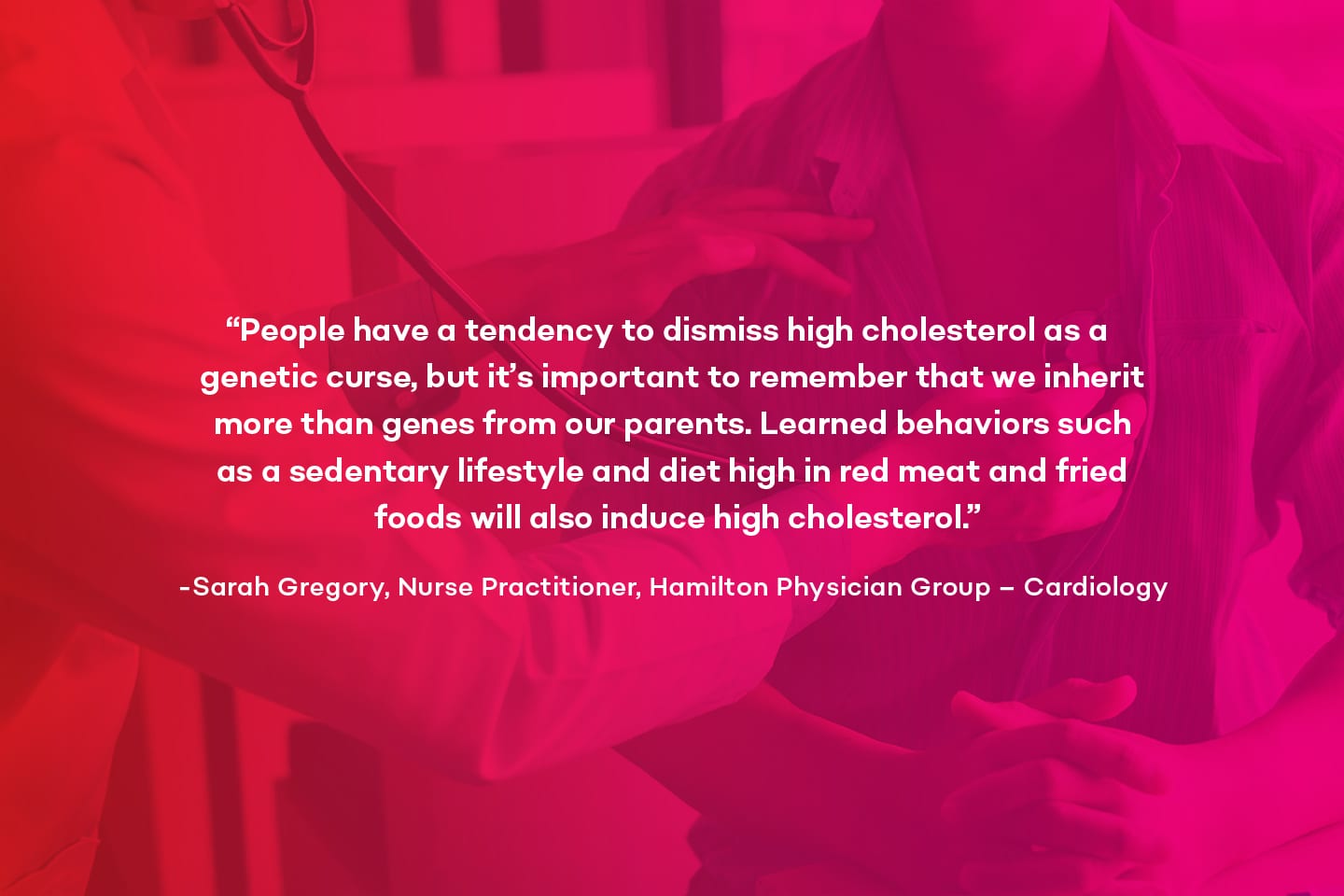The Good, the Bad, & the Ugly
We’ve all heard of cholesterol. In fact, most of us probably know it’s related to heart health. But when it comes down to it, you might be surprised to learn how much you don’t know about what it does, how it works, and when you should get your levels checked.
Here, we’ve compiled some of the most common misconceptions, along with their factual counterparts, to lift the veil on this important measurement and keep you feeling your best.
By Lucy Morris
Misconception: All cholesterol is bad cholesterol.

Family Medicine Physician, CHI Memorial Integrative Medicine Associates – Signal Mountain
Reality: While there are various types of lipid particles, there are two main cholesterol measures that people should know about: HDL and LDL. “HDL stands for high-density lipoproteins. We commonly call HDL your ‘healthy cholesterol,’” explains Dr. Chelsea Ryan, a family medicine physician with CHI Memorial Integrative Medicine Associates – Signal Mountain. “HDL helps to remove other forms of cholesterol from your blood and takes it back to the liver where it is ultimately broken down and removed from your body. Having high levels of HDL helps lower your risk of heart attack and other health problems.” LDL, on the other hand, which stands for low-density lipoproteins, is the bad stuff. “High levels of LDL can increase your risk of heart disease and stroke,” adds Dr. Ryan.
HDL and LDL work in tandem with triglycerides, a fat-like substance in your blood that gives your body energy, to create your overall cholesterol score. In a perfect world, you want high levels of HDL and low levels of LDL and triglycerides.
Misconception: If I had high cholesterol, I’d know.
Reality: Unfortunately, high cholesterol doesn’t tend to show symptoms, so the first sign that there’s a problem could be a heart attack, stroke, or peripheral artery disease. Since this is the case, it’s important to check your levels regularly, change your diet and lifestyle where necessary, and control your cholesterol with help from your doctor to avoid serious repercussions. High cholesterol is one of the most significant controllable risk factors for coronary heart disease. Just because you’re not seeing signs doesn’t mean you’re in the clear.
Misconception: Only men need to worry about high cholesterol.
Reality: Though high cholesterol is sometimes more commonly associated with men, men and women actually have similar cholesterol levels. While there can be subtle variations, they tend to be related to age and hormone levels. Sarah Gregory, a nurse practitioner with Hamilton Physician Group – Cardiology, explains, “Early in life women tend to have more ideal lipid profiles than men. This is because estrogen tends to increase HDL, which helps to suppress LDL. After menopause, estrogen drops, which causes a reduction in HDL and consequently, LDL increases.” Because of this fluctuation, it’s not uncommon for women to develop high cholesterol after menopause even if they haven’t made any other significant lifestyle changes.
Misconception: Cholesterol doesn’t need to be checked until you are middle-aged.
Reality: Though many people don’t think about getting their cholesterol checked until they’re older, it’s actually recommended to start early and retest regularly. Dr. Ryan explains, “The Centers for Disease Control and Prevention recommends checking cholesterol once between ages 9 and 11, once between ages 12 and 21, and every four to six years in adulthood.” Depending on your family history and your personal medical history, your physician may even recommend more frequent testing. “It is important to check cholesterol to help reduce the risk of developing coronary heart disease, stroke, peripheral artery disease, Type 2 diabetes, and hypertension.”
Misconception: Diet and physical activity alone dictate cholesterol levels.

Nurse Practitioner, Hamilton Physician Group – Cardiology
Reality: In addition to diet and exercise, genetics can play a role in your cholesterol levels. “There are a number of gene variants that change the way our bodies process LDL. For this reason, people with a family history of extremely high cholesterol should start lipid screenings at a younger age than the general population and often need medication in addition to lifestyle modifications to control their cholesterol,” explains Gregory. “However, sometimes people have a tendency to dismiss high cholesterol as a genetic curse, but it’s important to remember that we inherit more than genes from our parents. Learned behaviors such as a sedentary lifestyle and diet high in red meat and fried foods will also induce high cholesterol.”
Misconception: Thin people don’t have to worry about high cholesterol.
Reality: While overweight or obese individuals are more likely to have high cholesterol, body type alone cannot indicate cholesterol levels. Gregory explains, “Weight gain occurs from consuming more calories than we expend, no matter what the sources of those calories are, even if they are otherwise healthy, cholesterol-free foods eaten in large portion sizes. Therefore, it’s entirely possible to both be overweight with normal cholesterol and to be a healthy weight with high cholesterol.” For this reason, it’s important to get your cholesterol checked regularly, regardless of your weight, level of physical activity, and diet.

Misconception: With medication, no lifestyle modifications are necessary to correct high cholesterol.

Interventional Cardiologist, Parkridge
Medical Group
Reality: Cholesterol-lowering medication and lifestyle changes always go hand-in-hand. Dr. Maurice Alston, an interventional cardiologist with Parkridge Medical Group, explains, “Any time a doctor advises a patient to start treatment for cardiovascular risk factors – for example: hypertension, obesity, high cholesterol, diabetes – it should be with insistence on lifestyle changes. It has been shown that healthy eating along with increased exercise (150-180 minutes of moderate intensity exercise per week) can improve patient health and can improve short-term cardiovascular risk. Also, medication effects can be overshadowed by tobacco abuse, sedentary lifestyles, and poor eating habits. Lifestyle changes are the basis for good health outcomes.”
Misconception: Statins are dangerous.
Reality: Statins are prescription medications that can lower cholesterol and reduce the risk of cardiovascular disease, which is the leading cause of death in the United States. Unfortunately, they’ve gotten a bad rap over the years, but they are proven to have a long-term effectiveness in preventing cardiovascular events. “If you’re having trouble reducing and maintaining your LDL levels, then medication, specifically a statin drug, is recommended,” explains Dr. Alston. “Various statin medications have been studied with a 20-30% or more relative risk reduction in cardiovascular mortality. Over the years most non-statin medications have been studied with no mortality benefit, so statins should always be first line along with lifestyle modifications.”
Misconception: If the nutrition label shows low or no cholesterol, the food is “heart-healthy.”
Reality: Nutrition labels are meant to be viewed cohesively, so just because one row’s numbers look good, doesn’t mean the food is good for you overall. In fact, many foods marketed as “low-cholesterol” have high levels of trans or saturated fats, which can raise cholesterol levels. It’s important to read the whole label, and when possible, eat fresh, whole foods. Dr. Alston explains, “We should try to reduce or eliminate unhealthy food with saturated and trans fats while also limiting foods with unsaturated fats. To note, some fish cooked properly maintain high concentrations of omega-3 fatty acids, which can be healthy for you and even lower your bad cholesterol. The American Heart Association website www.heart.org is a great source for healthy living recommendations.”
Ultimately, you are your best advocate, and your health should always be paramount. Don’t wait until something feels “off” to get checked out. Establishing baseline readings – and retesting them regularly – will help you catch issues before it’s too late. Let 2020 be the year you start putting your health and wellness first!
